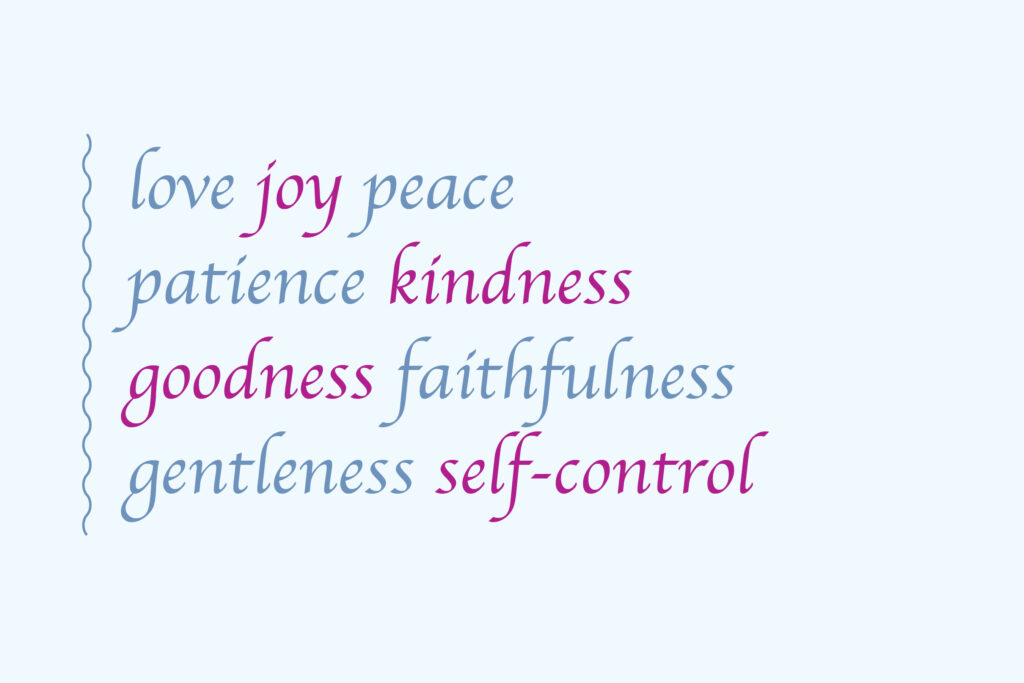
We love our characters. We give them flaws to make them relatable. We paint word pictures to show their strengths. We make them human.
Characterization roots our characters in our readers’ minds. The good news is the Bible provides us with a list of traits for our characters, the fruit of the Spirit.
Love
A character with an independent streak might accept help from others only when necessary (and sometimes not even then). Helping others becomes more of a chore than an act of love.
That same character might do chores for someone who has been injured. They raise money for a family in need. They love with their whole heart.
Joy
A character whose father dies and leaves the family in debt might keep the debt a secret. They push away offers of help from friends and family, and they work overtime to pay off the debt. They view life through a dark, gloomy tunnel without light at the end.
That same character might write down every good memory they had with their father. They pull their family together and plan a fundraiser to pay off the debt.
Peace
A character who lives on the streets because their one and only parent abandoned them might commit crimes such as stealing food while feeling guilty for such acts. They become wary of other people, especially those who offer help.
That same character might accept their lot in life and find ways to help others in the same situation. They finish their education and find full-time employment. They know God is on their side, no matter their circumstances.
Patience
A character with a sense of adventure might be impulsive, often doing things on a whim. They feel trapped when they’re in one place for too long. When trouble strikes, they run in the opposite direction rather than trying to work out the problem.
That same character might carefully plan out each adventure. They camp under the stars for a week with nothing but a book for company. When trouble strikes, they methodically think through their options.
Kindness
A character who was abused as a child might yell at people who try to help them. Their all-about-me attitude prevents them not only from asking for help but also from giving help.
That same character might befriend a child in the same situation. They become a mentor to the child and encourage the child to focus on their schoolwork.
Goodness
A character who likes to gossip might start rumors about other people to bring attention to themself. They spread secondhand information as if it’s true. They don’t admit when they’re wrong and instead blame others.
That same character might apologize for passing on information about another. They readily admit their wrongs while trying to become a better person.
Faithfulness
A character who has had their heart broken might throw themself into their work or another project. They refuse to see their friends. They feel anger toward the one who broke their heart.
That same character might throw themself into bettering their friendships. They invite their friends to their house. They make soup for a sick friend. They trust their life is not over even though a relationship has ended.
Gentleness
A character who is socially awkward might blurt out words without thinking, unintentionally hurting others. They do not seek forgiveness, simply because they feel awkward doing so.
That same character might give gifts to another person in secret. They write encouraging letters without signing them. They help out where and when needed without saying much but giving one hundred percent effort.
Self-Control
A character with a gambling problem might lie to their family and friends, keeping their problem a secret. They also lie to themself, promising they’ll quit or “one last time.” Gambling becomes their idol, and they act offended when anyone dares suggest they have a problem.
That same character might admit defeat to their family. They enroll in a rehab program and put their focus on volunteering at a homeless shelter.
But the fruit of the Spirit is love, joy, peace, patience, kindness, goodness, faithfulness, gentleness, self-control…
—Galatians 5:22–23



